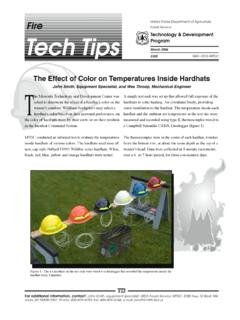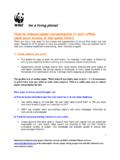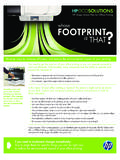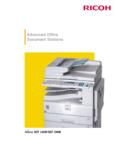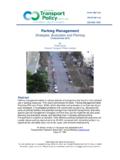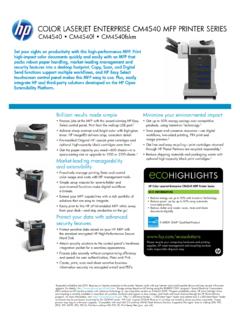Transcription of Monitoring Utility Costs and Consumption
1 Monitoring Utility Costs and Consumption Standard Operating Procedure Revision: Draft Date: August 2010 Prepared for: The Western Collective Sustainable Operation s Goal 1-B The Department of Agriculture (USDA) prohibits discrimination in all its programs and activities on the basis of race, color, national origin, age, disability, and where applicable, sex, marital status, familial status, parental status, religion, sexual orientation, genetic information, political beliefs, reprisal, or because all or part of an individual s income is derived from any public assistance program.
2 (Not all prohibited bases apply to all programs.) Persons with disabilities who require alternative means for communication of program information (Braille, large print, audiotape, etc.) should contact USDA's TARGET Center at (202) 720-2600 (voice and TDD). To file a complaint of discrimination, write to USDA, Director, Office of Civil Rights, 1400 Independence Avenue, , Washington, DC 20250-9410, or call (800) 795-3272 (voice) or (202) 720-6382 (TDD). USDA is an equal opportunity provider and employer.
3 To file a complaint of discrimination, write: USDA, Director, Office of Civil Rights, Room 326, W. Whitten Building, 1400 Independence Ave. SW, Washington, DC 20250-9410, or call (202) 720-5964 (voice and TDD). The USDA is an equal opportunity provider and employer. ACKNOWLEDGEMENTS The material presented in this report originates from a wide variety of sources, including personal experiences and communications, as well as the team members own knowledge. The report was developed through the collaborative effort of dedicated employees passionate about sustainable operations and wanting to make a difference.
4 The unique opportunity presented by The Western Collective was the catalyst behind getting the team s collective experiences down on paper and making it available to share with other Forest Service employees. TEAM MEMBERS Katrina Bowles; Accounts Resolution Technician ACE, Region 1 Regional Office Cherie Coolbear; Customer Care Representative ICU, Region 4 Regional Office Heather Davis; Engineering SCEP, Region 2 Regional Office Matt Gibbs; Social Scientist, TEAMS Enterprise Unit and Region 2 Regional Office Deborah Hennessey; Management Analyst, WO working remotely in Boise, ID Renee Jewell; Commercial Services Program Manager, Region 5 Regional Office Laurie Yeager.
5 Team Leader, Facilities Engineer, San Juan National Forest Special thanks to Vicky Duvall, San Juan NF, and Leslie Horsch, Bighorn NF, for their respective I-Web and editing expertise. TABLE OF CONTENTS ABSTRACT .. 11. INTRODUCTION .. BACKGROUND .. PURPOSE .. 12. THE PROCESS .. GETTING STARTED: ESTABLISHING LOCAL POINTS OF CONTACT .. CONTACTING YOUR Utility PROVIDERS .. BRINGING IT ALL TOGETHER: CONNECTING Utility BILLS TO BUILDINGS AND FACILITIES .. WHAT TO LOOK FOR IN Utility BILLS .. Utility ACCOUNT NAMING CONVENTION.
6 THE Utility BILL CLEAN-UP TEMPLATE .. CASE STUDY: SAN JUAN NATIONAL FOREST .. WHAT S NEXT: CONTINUOUS IMPROVEMENT .. 10 ACRONYMS AND ABBREVIATIONS .. 11 APPROVAL SIGNATURE .. 11 APPENDICES APPENDIX A RELEVANT GUIDANCE SUPPORTING THE Utility BILL CLEAN-UP APPENDIX B PAGES FROM NFC SEMI-ANNUAL STATUS REPORT APPENDIX C Utility TRACKING SPREADSHEET TEMPLATE APPENDIX D I-WEB PROCESS TO GENERATE THE BUILDINGS AND FACILITIES REPORT (APPENDIX E) APPENDIX E BUILDINGS AND FACILITIES SAMPLE REPORT FROM I-WEB APPENDIX F SAMPLE Utility BILLS APPENDIX G SAMPLE LETTERS APPENDIX H SAN JUAN CASE STUDY APPENDIX I Utility INVOICE PAYMENT INFORMATION Monitoring Utility Costs and Consumption 1 Standard Operating Procedure ABSTRACT This standard operating procedure has been created by a multi-disciplinary team of Forest Service employees with varied backgrounds, including budget and finance, engineering, and sustainability.
7 Many of the team members have completed a variety of Utility bill clean-up efforts and have combined their working knowledge to help navigate the clean-up process. The goal of the Utility bill clean-up is to provide the tools necessary to understand the cost and Consumption associated with a unit s energy use, water use, and solid waste disposal and to identify places where efficiencies in billing and Consumption can be made. At the completion of the Utility bill clean-up, a unit will be able to make informed decisions about Utility services and improve operational efficiency.
8 Results are predominantly from a reduction in the number of improper payments. Reducing improper payments results in dollar savings and improves a unit s ability to reliably monitor energy and water usage. 1. INTRODUCTION Background Within a single forest, facilities can be found in urban settings, remote locations, and everything in between. This means a single Forest has numerous electricity, water, natural gas, propane, and solid waste providers. Since facility managers on these forests do not pay or receive the Utility bills, awareness of their Utility usage, the associated Costs , and the ability to track usage can be a challenge.
9 Obtaining information about Utility bills is not an easy task since the majority of bills are sent directly to the National Finance Center (NFC). This standard operating procedure (SOP) has been developed to bridge the difficulties with this data retrieval gap and build the knowledge needed to better track Utility usage and expenditures. In the last several years, there has been an increased emphasis on reducing energy and water Consumption in federal facilities through Executive Orders (EO) 13423 and 13514, the Energy Policy Act of 2005, and the Energy Independence and Security Act (EISA) of 2007.
10 To meet these goals, agencies are required to establish a baseline of use for electricity, water, etc. In addition to properly identifying all the Utility accounts held on a unit, this SOP will help build a baseline of use that will assist decision making and provide a benchmark against which future progress can be measured. Furthermore, improper payments will be identified. Eliminating improper payments will simplify data tracking and save money a nd it is also required under EO 13520. Refer to appendix A for the different criteria designated in the different EOs, EISA, and EPAct.








